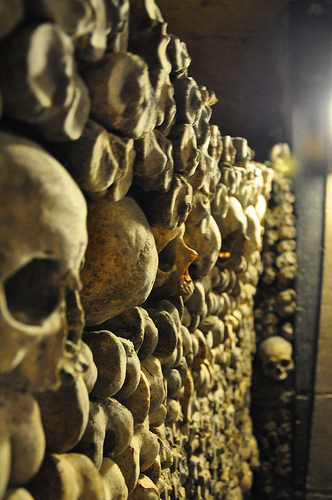I found the entrance to the Catacombs of Paris clearly marked near the Denfert Rochereau Metro stop. The Catacombs are a network of tunnels and caves that run for more than 300 kilometers under the city. The Romans were the first to quarry the limestone in the city in 60 B.C. As the city grew and covered the landscape, tunneling was required to acquire more building materials. The quarries grew in size and complexity and produced building materials for centuries to come. Quarrying continued with reckless abandon until problems began to arise. Buildings began to collapse and fall into the earth that was opening up below.
A second problem arose–the graveyards were getting full. The Cimetière des Innocents (Cemetery of the Innocent) alone held more than thirty generations of human remains. Thus starting in about 1777, the tunnels were fortified and human remains–hundreds of thousands, if not millions–were removed from cemeteries and stored in the tunnels. The storing of human skeletons in the Catacombs continued for a century and a half, and they are still there today. The walk through the Catacombs takes a little less than an hour. Only about a hundred steps took us under the streets of Paris. Water dripped from the ceilings and voices echoed. Most of the tunnels in this maze were closed to the public due to people frequently getting lost. If they weren’t, you really could wander beneath Paris for forever. It was spooky. Human bones including heads, legs, arms, and every bone in between are stacked 6-8 feet high along the edges of the tunnels for miles under the streets and buildings. At the end of the public area and at the top of the stairs, a hundred more stairs to be exact, is a first aid station complete with a defibrillator and the French version of an EMT.









